PRE-EXCURSION EXPULSION
The week before I travelled to Sweden and Finland I contracted a stomach bug, probably from my niece whose little hand I held all day while she didn’t feel good (”really not good, auntie…”) at a Milwaukee Brewers game.
The virus made landfall as pain while swallowing, which I noticed and pretended not to notice. As the day flowed on, chills accrued, then aches in all my limbs’ hinges, then a vat of putridness churning in my stomach that sent fumes up to my sternum.
Eventually I crawled on hands and knees to the back porch, slid open the screen door, and threw up in a way that was satisfyingly compulsory. The next few days were blurred by pukiness and lethargy, and were peaceful. As a cherry on top I got my period.1
A violent and comprehensive purging, and I was ready for Scandinavia.
FIRST IMPRESSIONS
[And now, I generalize wantonly.]
“Swedes are so Swedish” is one of my first thoughts after debarking the bus and taking a preliminary look at the citizenry.
I knew Swedes to be chronically well-dressed, favoring neutrals and embracing monochrome with abandon. Last fall in Helsinki, a cohort of Swedes assumed I was Finnish because of my “colorful hat.” (Red beret—admittedly pretty jaunty.) Out of Swedish heads of all ages sprouted the platonic ideal of blonde. Laughably poreless and creaseless gold skin abounded. Between their genetic palette and preferred wardrobe, the Swedes were—visually—the human equivalent of a beige paint sample.
Even the architecture was predominately some shade of Creamsicle, which I learned was the result of one bold city planner who traveled to southern Europe, returned to Stockholm smitten with Spain’s late-day sun, and painted the town ochre. (Who among us hasn’t doused our surroundings with an outsized portion of global influence after a world-rocking trip?) I wondered why “Swedish tan” wasn’t a Pantone hue.
I also knew, based on good Finnish intel, that Swedes could be as buttoned-up interpersonally as they were aesthetically. While a Finn will famously say nothing if he or she has nothing to say (and because Finns are—adorably—quite shy), a Swede is apt to cast a courteous line of smalltalk. Haters (Finns, occasionally) will call it phony, but I came to believe this initial guardedness blooms out of deep roots of Respect For Another. Swedes aren’t shallow, they’re just reluctant to dive into reality’s deep end non-consensually; like hugging someone and pulling them into the pool with you. Better to tip a toe. At least until both parties feel like swimming.
I was glad to have been tipped off on The Swedish Way so I wouldn’t prod. (I’m not renown for my social boundaries.) I interacted at a Swedish pace.
In fact, I realized it was fitting—ideal, actually—that I was visiting when I was, as I was arriving uncharacteristically subdued. I was worn out from puking my brains out, but my spirit was a little threadbare, too. Ever been there? Your heart has a head cold. There’s a hair in your mouth, a kink in the hose. The doors just closed. In times like these, which can last years, I feel I am perpetually driving on life’s shoulder. The road is bumpy and “off” and worst of all, it’s impossible to forget it even for a second.
Stockholm wouldn’t necessarily be my first port for exhilaration, and maybe that was right. Maybe what I needed was to be immersed in moderation. To be underwhelmed. To eat shrimp salad and look at salmon buildings.
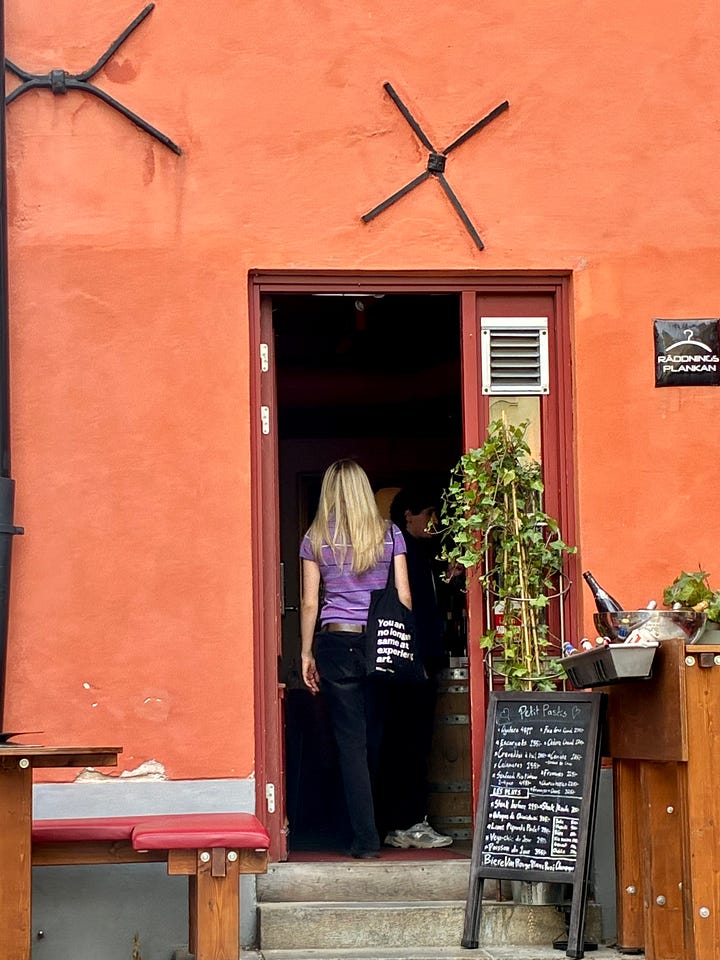
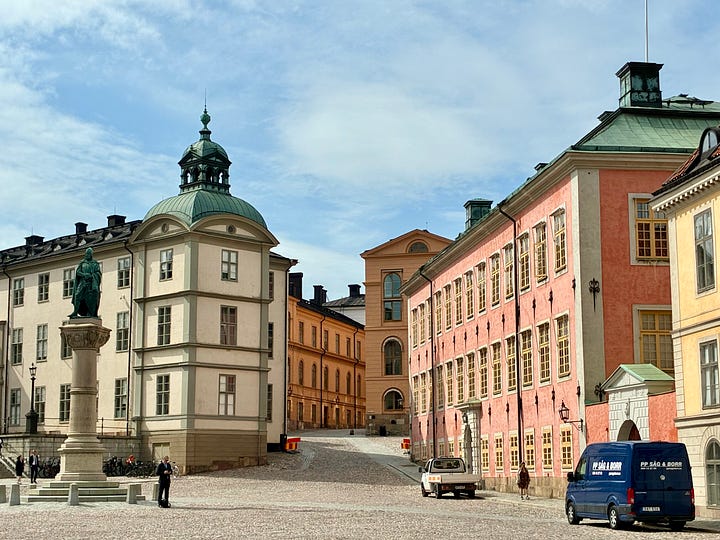
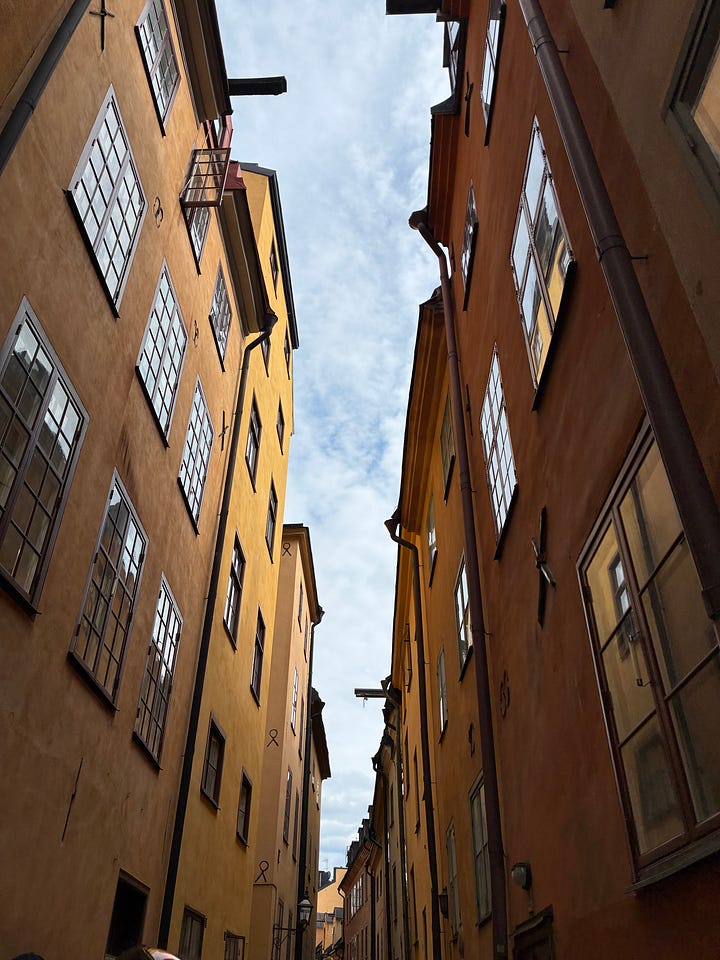
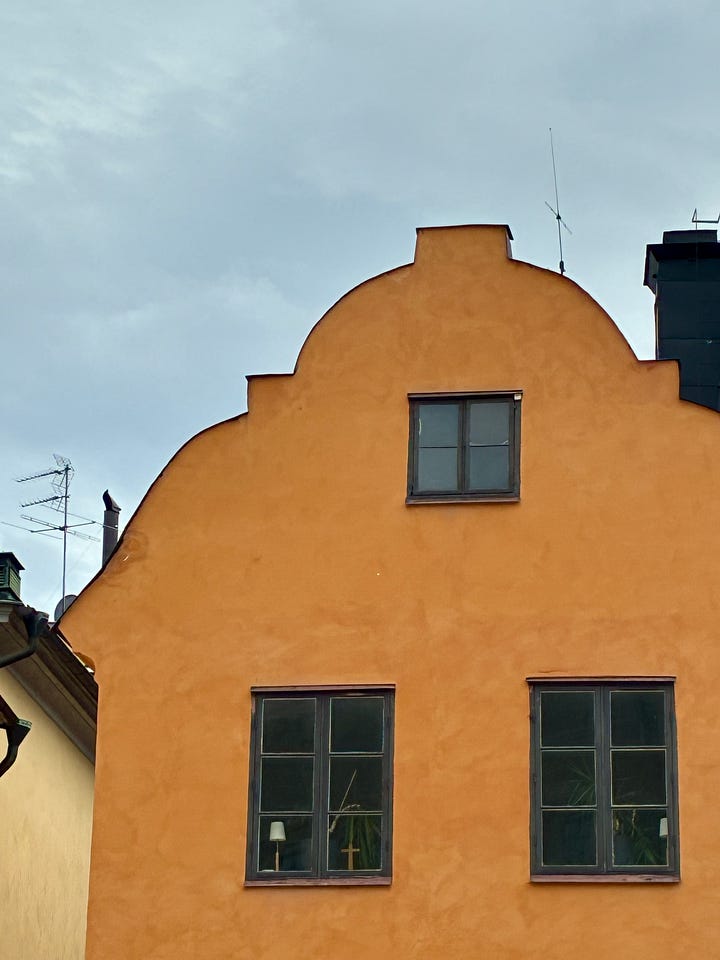
PER (AIRBNB HOST)
Per and I are both copywriters, it turns out. He was born in 1962; I penetrated this spinning rock thirty years later. We both like morning swims chased with coffee in the sun. We dislike too much sugar in Chinese food. We bake sourdough. We read Sally Rooney. Neither of us wears our bike helmet as often as we know we should.
Sometimes when I toss a joke out to Per, it’s like one-sided catch: He simply picks the ball up off the ground and throws it back without comment or shame. He writes my most treasured Airbnb review.
On my first night in town Per gives me an uplifting bike tour. He seemingly knows everyone, waves “hej” to him or her—”Hi Clara!” “Oh, I know that guy.” “That’s my friend. I was at his flat yesterday.” We run into an old classmate from advertising school and his wife and crash their dinner. The woman is a fashion designer and inputs vintage stores into my Notes app. The man, another copywriter, coyly urges me to try a tunnbrödrulle, a dish seemingly composed of all Sweden’s mainstay dishes—mashed potatoes, hot dog, shrimp salad, regular salad, ketchup, mustard, mayo—wrapped in a flatbread. I respond with genuine silence.
Throughout the evening and next day, I contemplate the item. When will be an appropriate time to consume it? When might I crave something akin to it? I know only that the time will come, and that I am unequipped to see it coming.
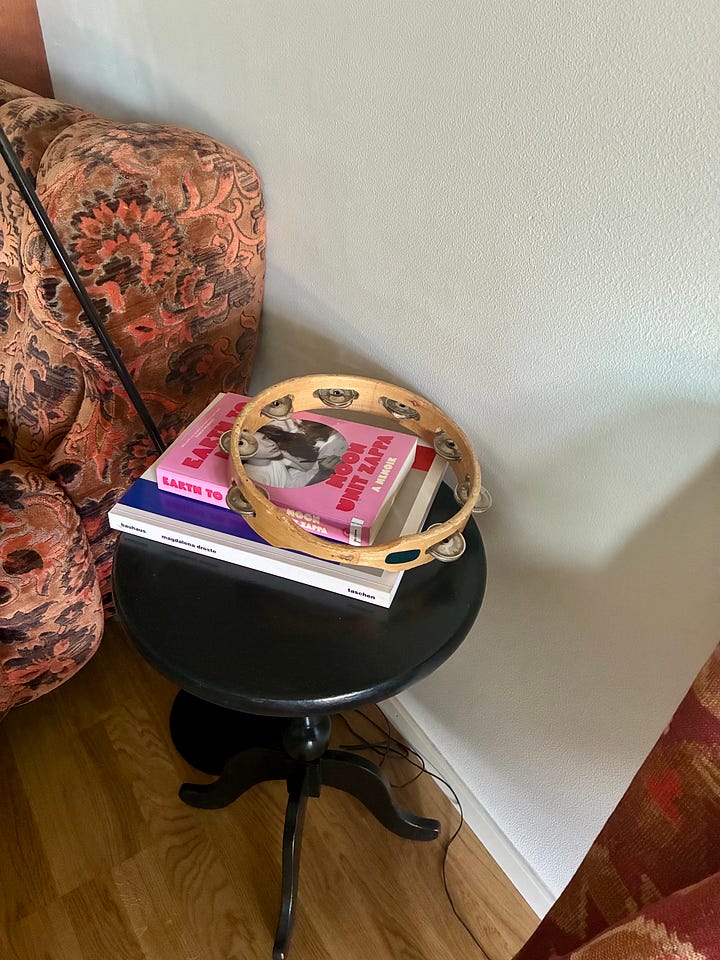
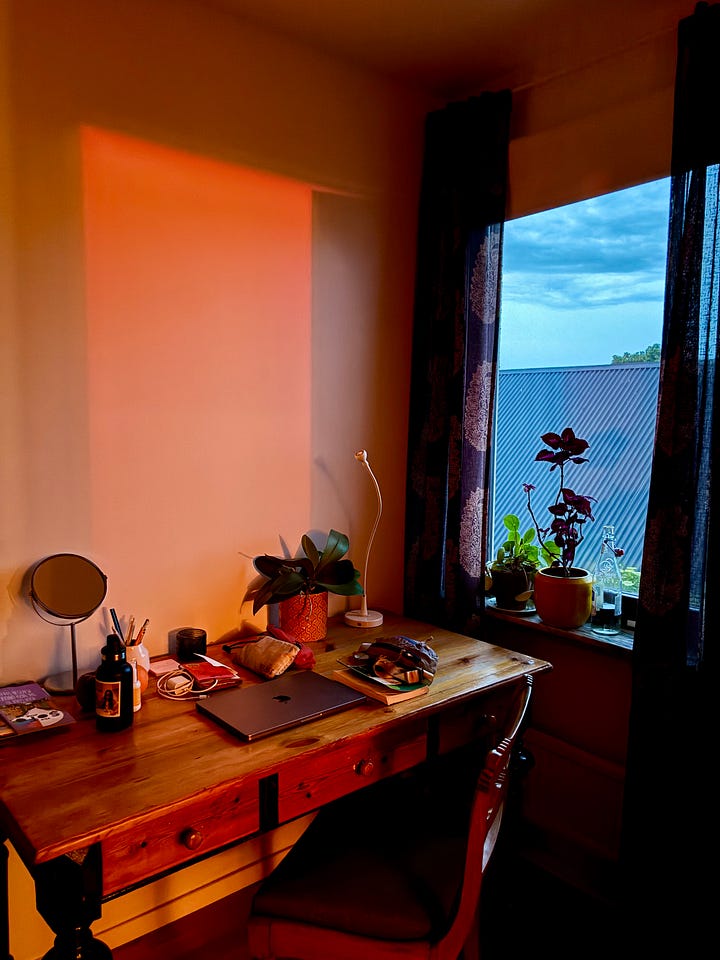
REOCCURING THEMES
Every night on my trip I log my five favorite moments from the day. The first night, I think about how earlier on the Swiss Airlines red-eye over I had woken up, seen my seat mate buttering a roll, and shrieked, “Did I miss breakfast?!” so disoriented and maybe endearingly distraught, the college-aged girl behind me giggled. My seat mate, a middle-aged woman from Munich, quickly asked a passing flight attendant for another breakfast tray on my behalf.
It felt like love.
I sat swaddled in a patchwork cocoon of travel textiles (airplane blanket, jean jacket, scarf, bucket hat) finishing a 1974 Swiss film2 sipping watery coffee at 4 a.m. safely encapsulated somewhere over Zurich, my surrogate fairy godmother watching German reality TV at my side.
That was the first time I accepted a stranger’s generosity on the trip. Throughout the next two weeks I did it over and over, incrementally grasping I was trafficking in grace.
Grace is this invisible currency you can pay for things with, sometimes, if you walk around open and slowly enough to recognize it and hold it briefly before offering it to the next person. It is a free, sun-warmed pond you can back-float on but can’t try to swim in or else you’ll drown. Personally, only once I’ve exhausted every effort and am almost completely depleted can I mingle with grace.
ONE OF THOSE NIGHTS
I meet up with my friend, then two of her friends arrive lubricated from a corporate event with free sunglasses and alcohol, then one of their friends arrives high on the thrill of just scoring an unbelievable deal on yeast. He stocked up. He doesn’t even use yeast. At the slightest whiff of incredulity, he bounds out and back with a plastic sack full of yellow cubes, which he distributes grandiosely to us all. Tiny stacks of yeast pockmark the picnic table; some Gen Z Swedes passing by eye it curiously, maybe their first unselfconscious gesture all day.
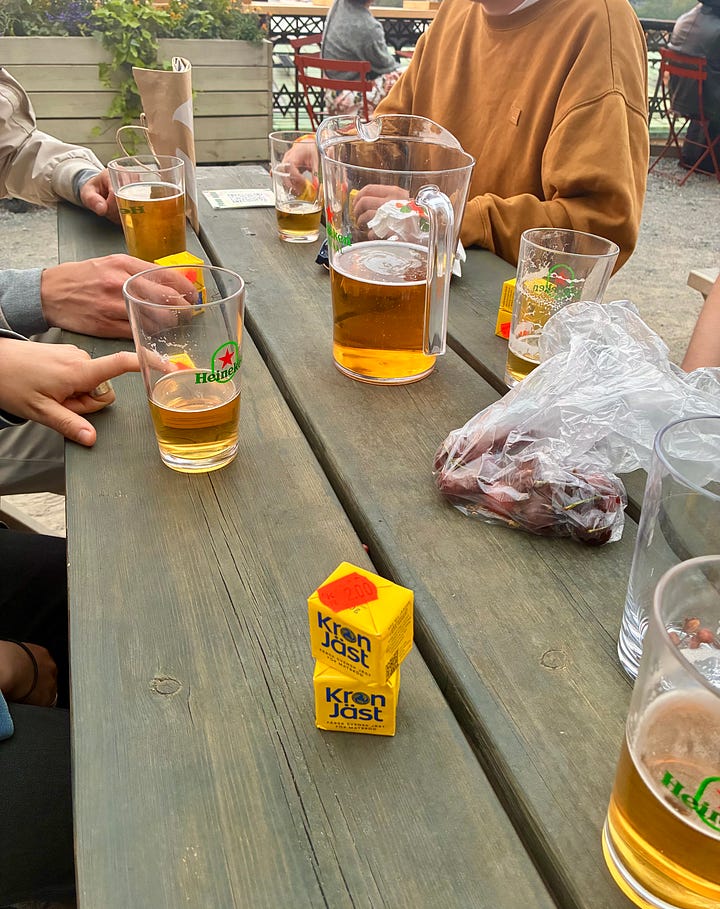
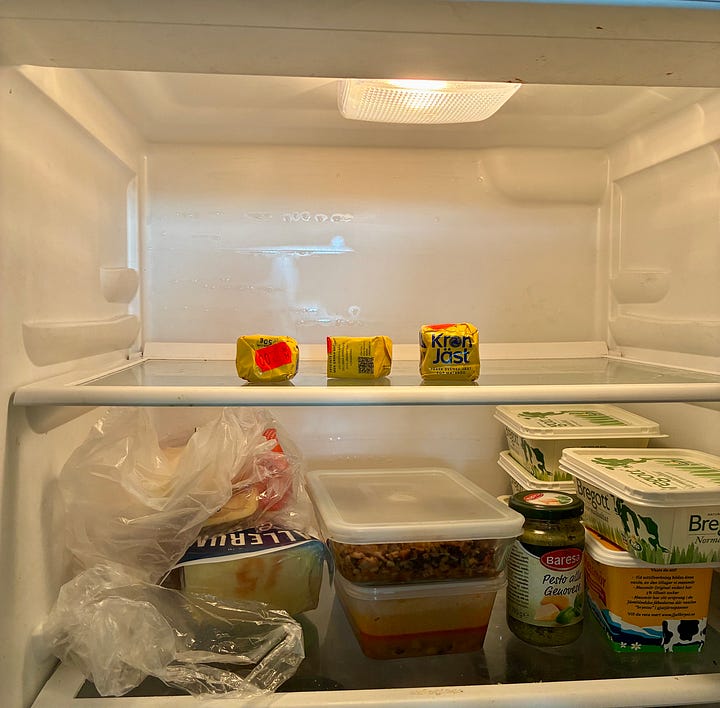
It’s one of those nights you have sometimes. Things work out.
Like: One of the friends loaded up on free candy at the event. Swedish candy is a Thing in the States right now, we all simultaneously realize; I should experience it. He starts passing me morsels—a gummy Ferrari, a cloud-like mushroom, a black licorice pellet—sporadically throughout the evening, and I grasp and consume them wordlessly, like a toddler blithely accepting snacks from her carseat.
I am the foreigner—the impromptu guest of honor—so when I return from the bathroom at one point admiring the casually sublime skyline, they present me the option:
“Fancy bar or shitty bar?”
I don’t hesitate. “Shitty bar.”
A round of hoorays.
Later my friend and I follow the night’s natural end to a beloved late-night fast food kiosk. She gets two scoops of mashed potatoes and a cute blob of a ketchup. And there it is—the tunnbrödrulle. I get it. I have to.
It has the physique of a prairie dog. A wiener protrudes flagrantly. I go in. And it’s like Heaven’s skies opening, angels singing, clouds parting. It is so good.
Life is reliably flabbergasting.
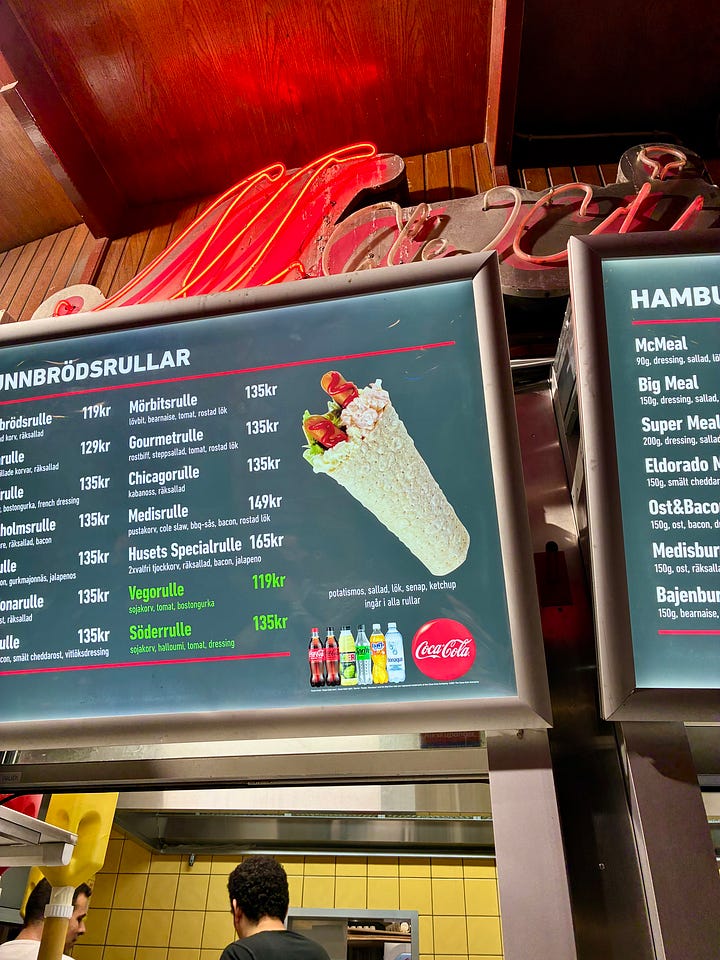
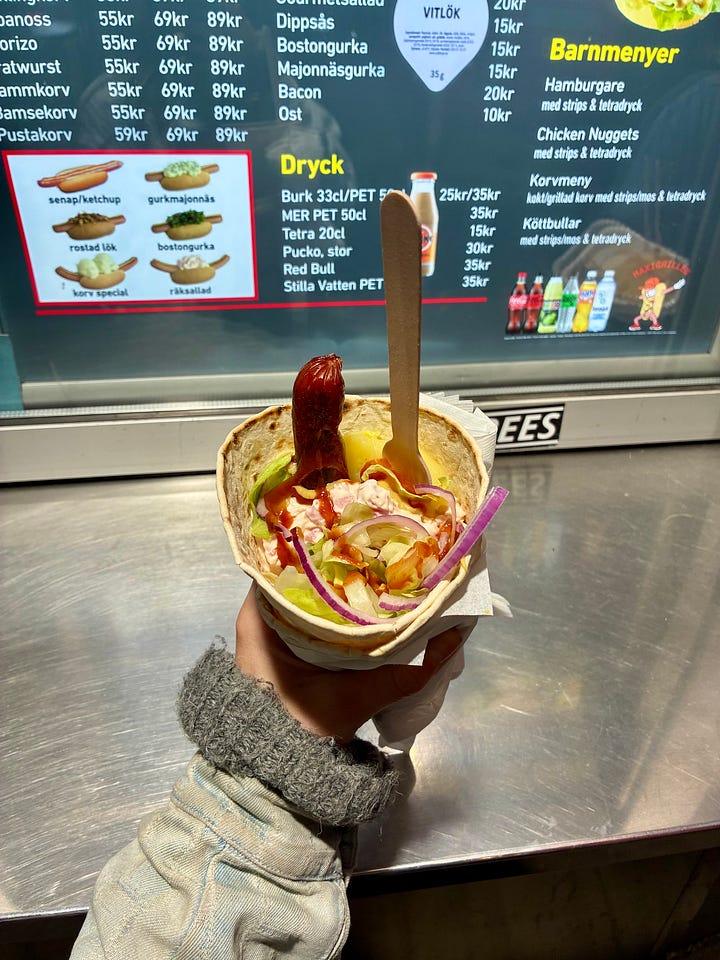
WALKING TOUR IN OLD TOWN
I ask a man if he’ll take my photo in front of the sloshy sea and perfunctory buildings. Afterward we marinate in the view side-by-side and I say it’s funny how the houses look like the kind you draw when you’re a kid, with perfect-square windows and doors. He says it’s a bit different where he’s from… (China, he clarifies.)
I ask how kids draw houses in China?
He says when you’re little you usually draw walls, actually—the wall to the village. With a gate, maybe. A big gate.
The tour was offbeat and buoying, but that thing about how kids draw houses in China—that was my favorite fact.

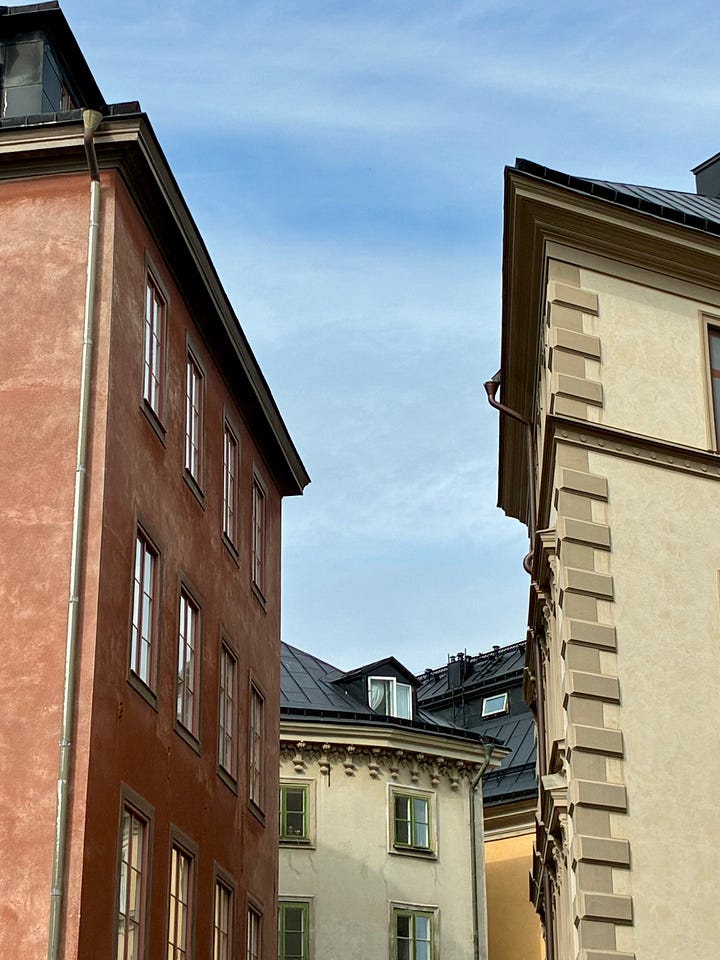
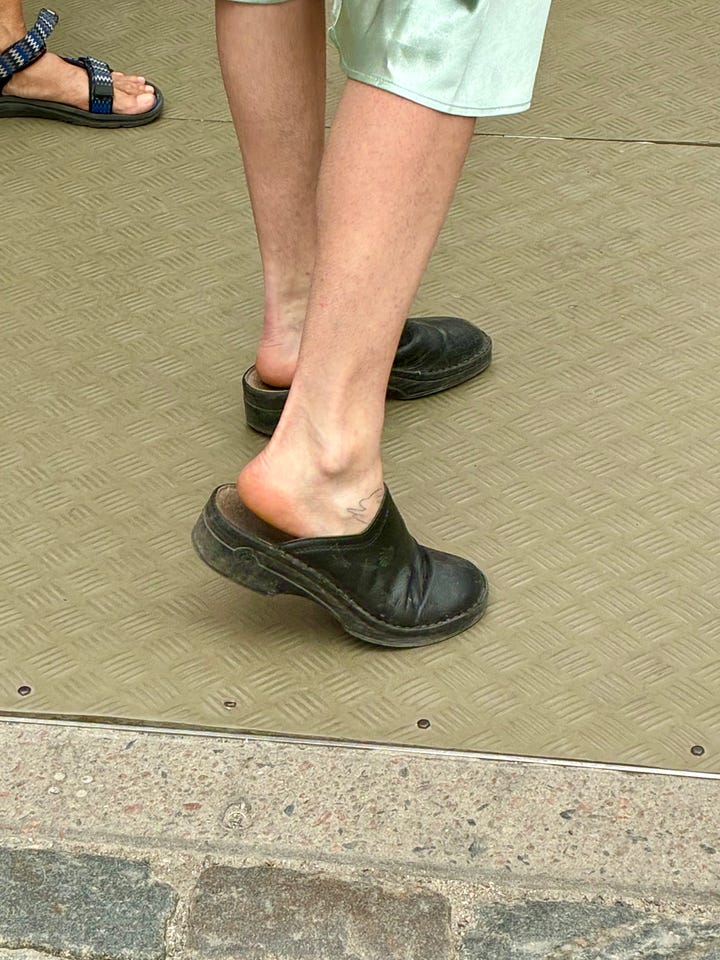
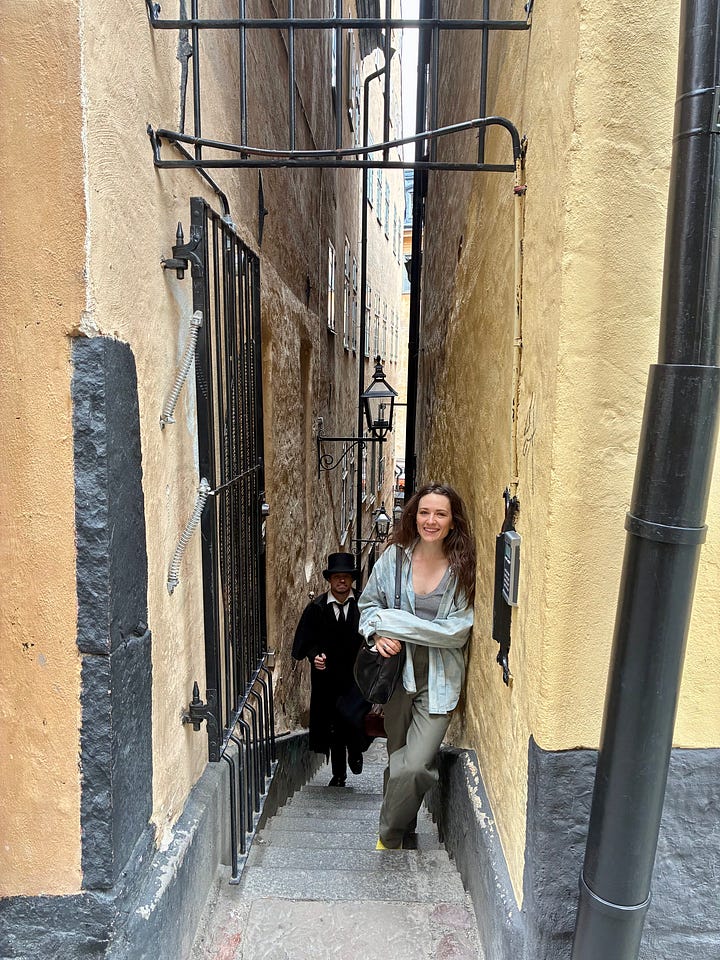
AT THE SWEDISH SPA
There is a naked man roaming the baths. He comes in and out, no towel in sight, and something else notably in sight. I once read that our cell phones activate the same part of the brain as a mother with a newborn. While she goes about life, a portion of her cerebrum is continuously monitoring her child, wherever it may be. The same effect occurs when our phone is in our vicinity. Horrifying, in that context, but that’s how I feel about this man. Try as I do to be In The Moment, part of my brain is calmly keeping an eye on it. I mean him.
I go into the dry salt sauna, a pale apricot-marble cave garnished with photos of the world’s deserts. It is the only room that features a plaque, which explains about Hu. Hu is the sound of everything and nothing, the sound of love, the sound behind all sounds. Chanting the word “Hu” can silence the ego and transport one to a place of higher guidance and inspiration, apparently. I give it a try.
I am “Hu”-ing, quietly, when the naked man comes in. An older woman with tattoos does too. She turns to him, “You can’t be in here without a towel.” He looks at her. She says, “You have to have a towel.” (It’s true, the guy at the front desk said that.) The man stands silently and leaves. The woman turns to me. “I’ve been going here fifteen years. That’s the first time I’ve seen a cock.”
I fall asleep to a recording of sand dunes. I sleep for a nice while in Sweden with warm simulated desert air blowing all over me.
EXISTENTIAL ICE CREAM BREAK
In the late afternoon hard rain arrives uninvited, unanticipated, but not unwelcome. I take cover in a courtyard after being lured by a crude statue of a pony and eat a strawberry gelato. (I’d been seeing people eating ice cream at all times of day around the city—sign of a well-adjusted populace.) Melancholy with a swirl of anxiety drifts in. I deflate a little. I droop.
I nibble the cone. There is nowhere to run. You can’t enjoy the good times too much, because it’s greedy. And anyway the bad times will come. You’ll be sad again. You’ll be glad again. You’ll be sad again. You’ll be glad again. Baffling teeter-totter. Indomitable seesaw.
Maybe one thing was to find someone whose face you could bear to look up at and down at and right at, those times you floated in equilibrium, legs in the air.
MIDNIGHT IN THE FOREST CEMETERY
A thick nap dilutes the ennui but doesn’t eradicate it. I will go for a walk in the forest cemetery—that should lighten the mood. Still-light 10 p.m. skies tell me it’s okay.
It’s after 11 by the time I arrive at Skogskyrkogården, a UNESCO World Heritage Site I plucked from an unassuming Reddit comment. It’s a bright midnight, will be the brightest of the year, tomorrow being the solstice. Two tender hills are fuzzy with pale grass recently cut; some elms crown one. I recall a line from a book: “No woman is as beautiful as a hill.”
I kickstand my bicycle next to a croft of graves in case a spirit wants to take it for a spin, for old time’s sake. A hare stares through me. (Large delusional rabbits patrol the property, loping madly then freezing at whim.) I can’t quite untangle the ironies of being most afraid there’s another living being in the cemetery who may kill me.
The architectural historian on the free online audio guide says the cemetery owes its arresting nature to a profusion of visual contrast. Scandinavian sun perforates forest darkness, stands of towering pines abide over homely, moss-bound headstones. But the cemetery’s unkemptness complements death perfectly. Both are unruly. It’s consoling to acknowledge it.
Maybe cemeteries are eery because of our creepy efforts to groom them, like a Barbie after you insist on brushing her hair. Human interference guarantees distortion. An incidental pun appears in my mind: manicured.
I wonder if the site would be even more affecting if the graves weren’t marked. Concealed lives under trees… we’re already that.
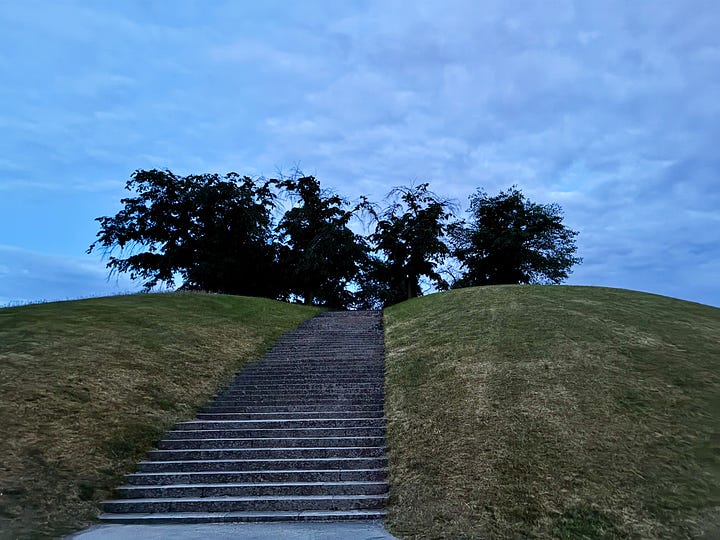
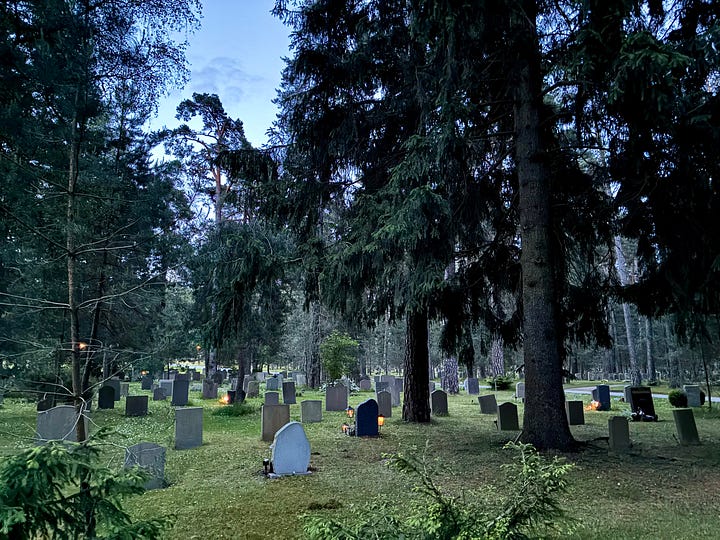
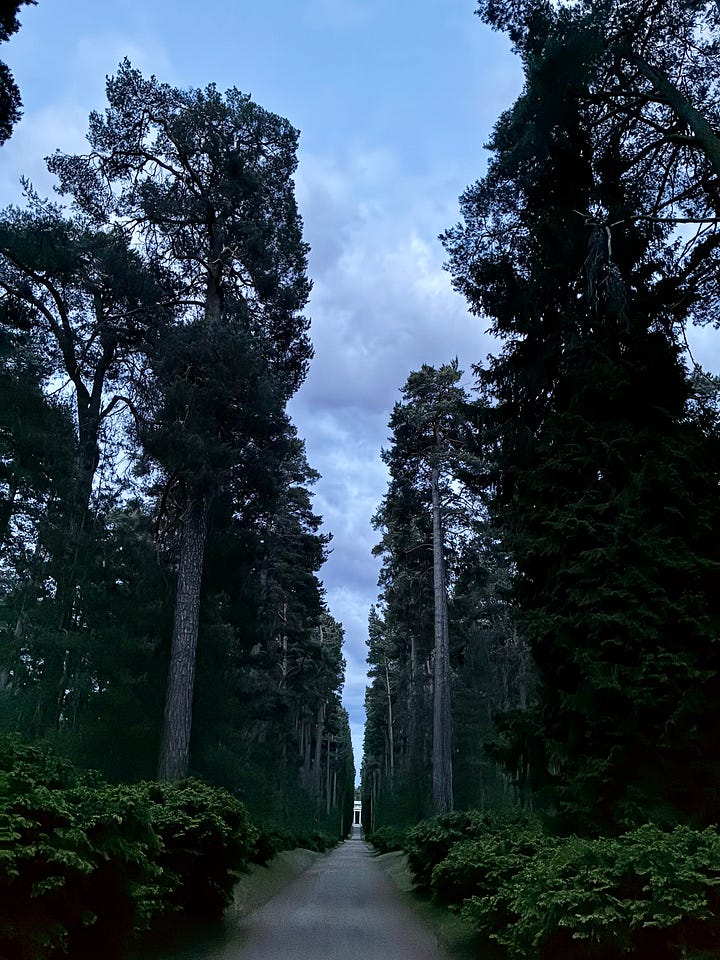
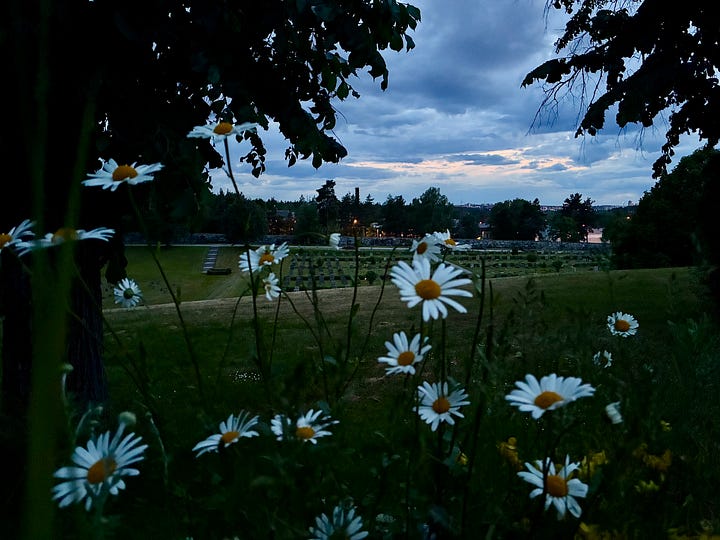
AT SEA
The next morning I board a ferry through the Gulf of Bothnia to the Finnish archipelago. It’s repulsively early and I've racked up a sleep deficit, so I down a cup of coffee and crash in a crooked slump on a bench. Hours later I open my eyes to a butt. (baby) I swallow the cold sugary dregs. Luxury is usually cheap, actually.
On-ship entertainment has begun; I have unwittingly secured a front seat. Children perform Finnish pop hit-karaoke in an expansive piano bar to their weary moms. Outside, crumply teal waves rumble and unfurl into wide, coarse swaths not unlike the granite rocks they splash up against on the islands. The sun makes the sea-face look leathery.
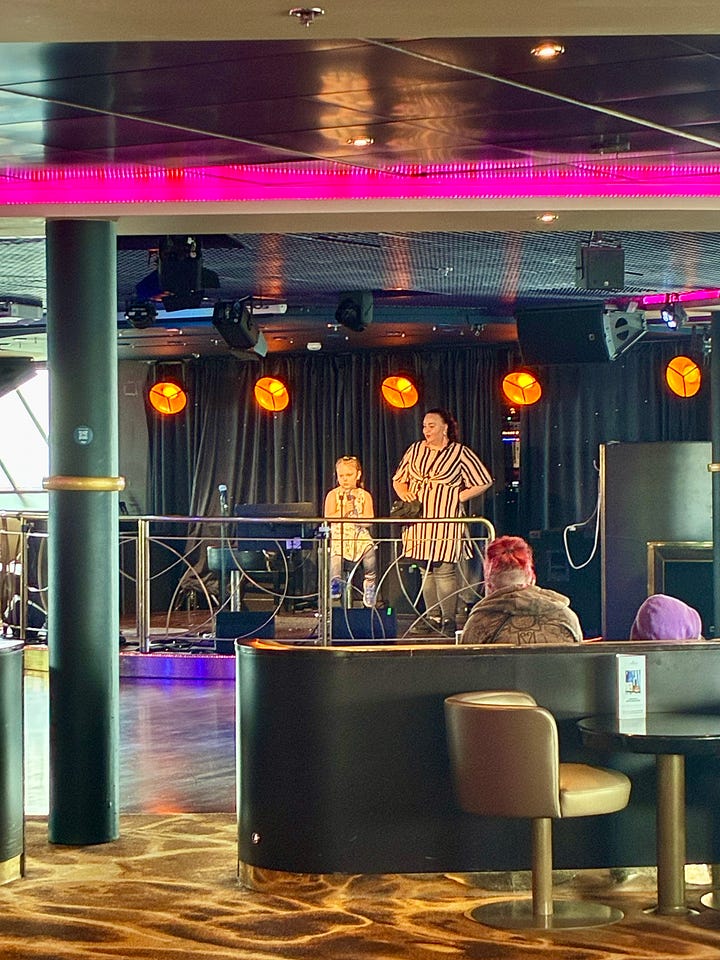
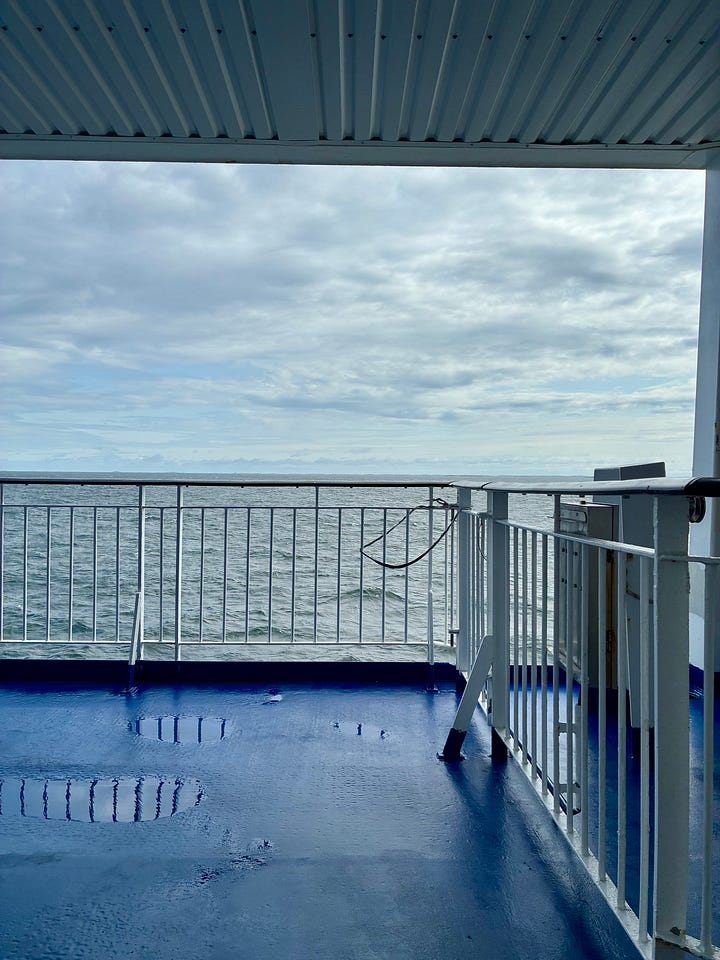
The day is mostly cold and blue, intermittently I am too. I perform a textbook overboard peer. The wind threatens my hat.
At lunchtime I slip into a face-off in foreign waters with the cashier at the on-ship café. He won’t let me get the child’s portion of Swedish meatballs.
“The child’s portion is for children,” he explains.
We stare at each other. I am standing on the ledge, I am this close to saying—somehow explaining—"I am a child."
But he is impenetrable; petrified wood. Numb, I order the adult portion. I joylessly consume 2.5 meatballs, roll the rest into a takeout container, and tote it around all day. Later I pilfer a tea bag remorselessly. It is possible (and healthy) to drain our ever-filling reservoir of spite in private, innocuous spurts.
I’d been munching my way through Tove Jansson’s novel Fair Play, which features this mind-salve of a passage in the introduction by Allie Smith:
“This novel is about creativity from the very start—about how you take a day, the same as all the other old one-after-the-other days, and make it really new and fresh... It features an immediate challenge to vision—it is very much about how to shake off old ways of seeing, how to see things differently, get rid of what’s “hopelessly conventional” and replace it with something more hopeful.”
I look out the window at the soft green sea and decide to take it like medicine. I would turn a boat into a sanatorium. I self-prescribe two hours of directionless staring. Some walking. Baltic wind for the skin, for the nerves. More moderation.
More!!!!!
No pun intended 😈 🍒
Alain Tanner's Le milieu du monde (“The middle of the world”)




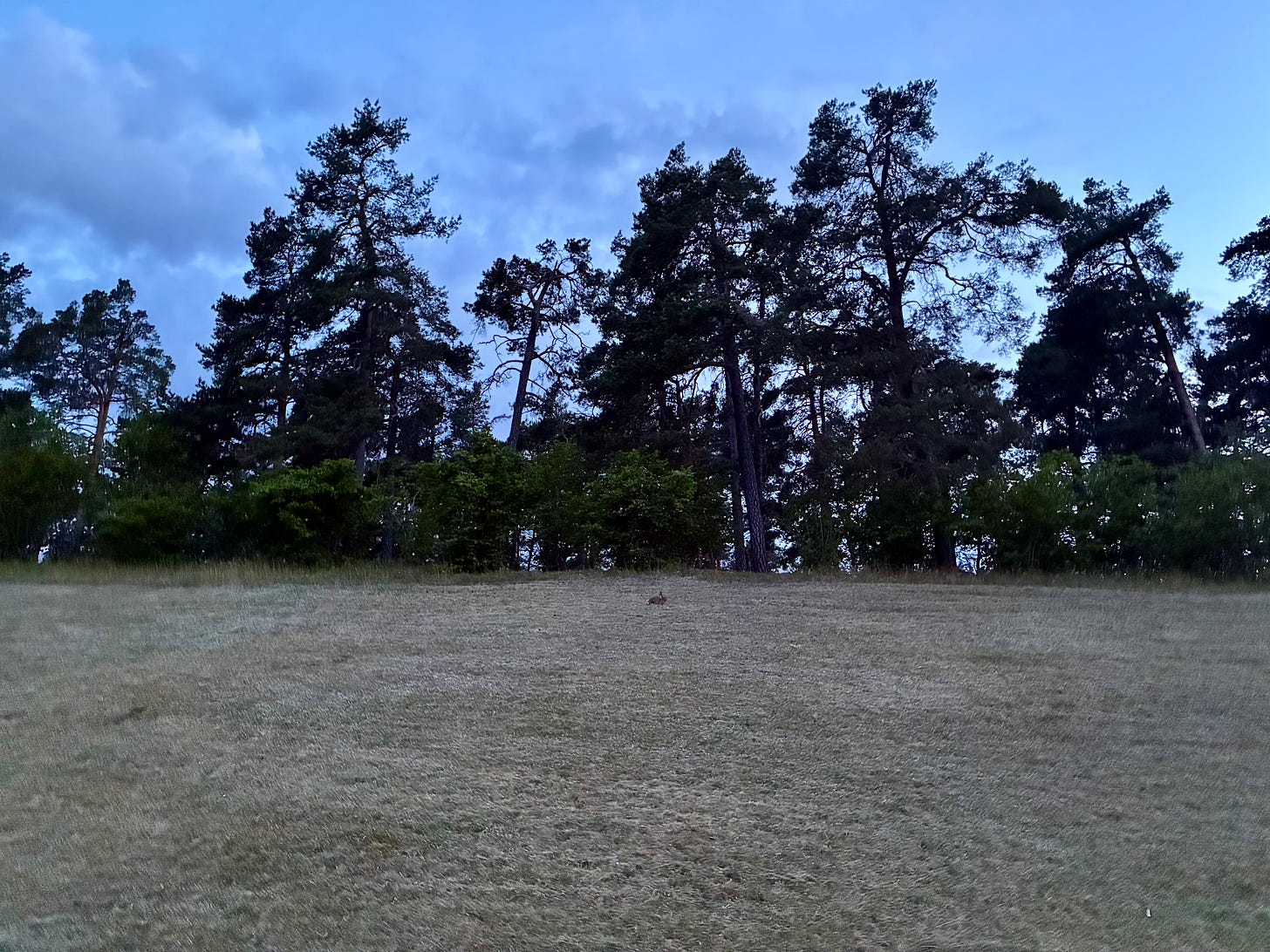
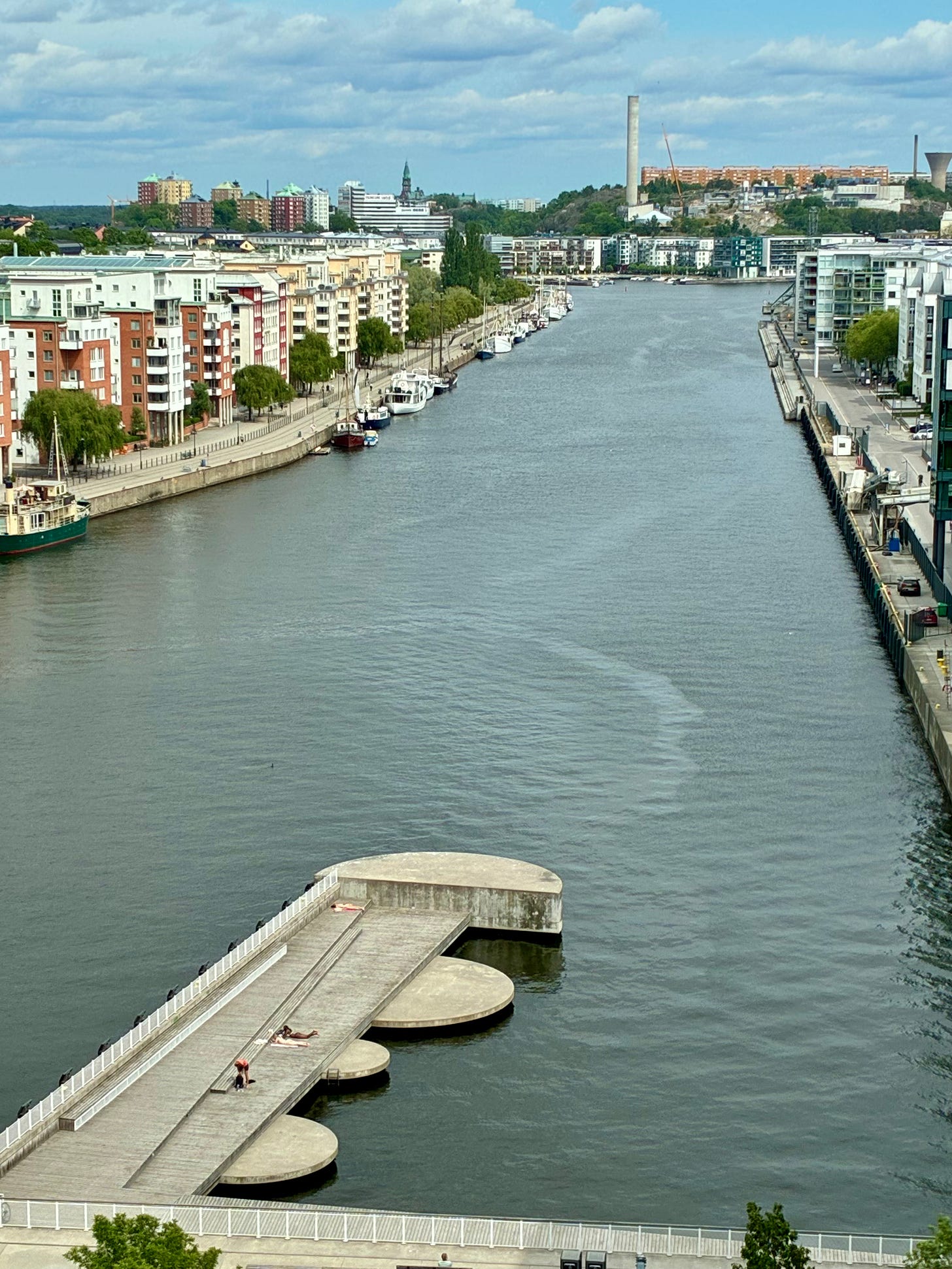
You have a gift! I'm already beginning to see the monochromatic beige of Irvine in a kinder light.